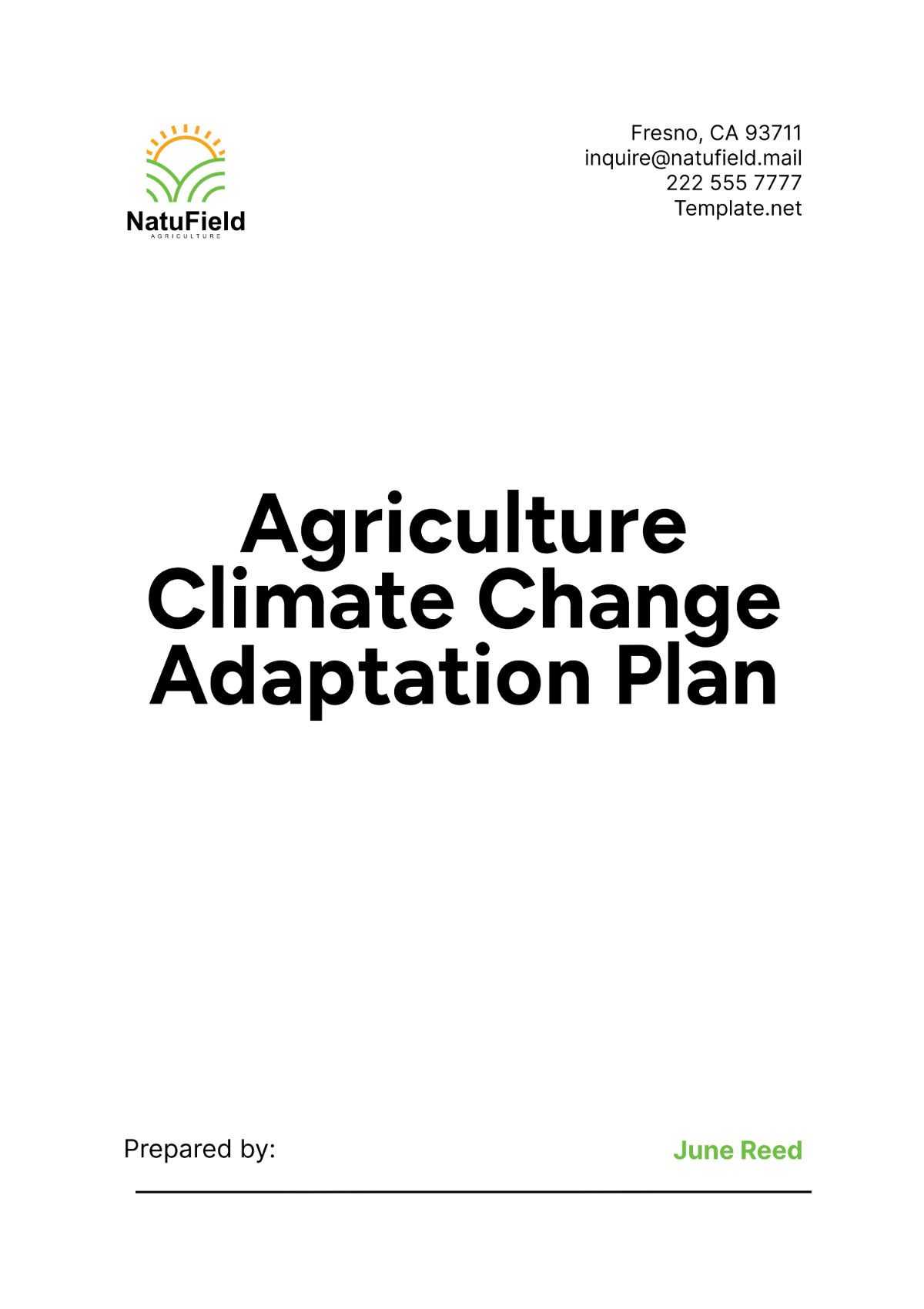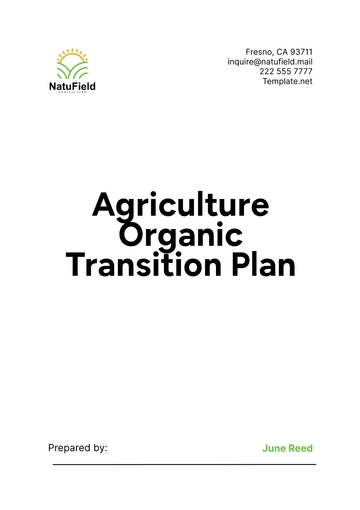Free Agriculture Climate Change Adaptation Plan

I. Introduction
As our global climate continues to change, it is crucial to develop strategies that ensure the resilience and sustainability of our agricultural systems. [Your Company Name]'s Agriculture Climate Change Adaptation Plan aims to identify and address the specific challenges posed by climate change to our farming operations. The scope of this plan encompasses the assessment of current and projected climate trends, the identification of vulnerabilities in our agricultural systems, and the implementation of adaptation strategies that will safeguard our crops, livestock, soil health, and water resources. By adopting these measures, [Your Company Name] aims to enhance the resilience of our agricultural practices and secure a sustainable future for our farming community.
II. Current and Projected Climate Trends
A. Temperature Changes
Over the past century, average global temperatures have risen significantly, with projections indicating further increases. In our region, the average annual temperature has increased by 1.2 degrees Celsius over the last 50 years. Future climate models predict an additional rise of 2 to 3 degrees Celsius by 2050. These temperature changes can have profound effects on crop growth cycles, pest and disease prevalence, and livestock health, necessitating adaptive measures to mitigate their impact.
B. Precipitation Patterns
Climate change has also altered precipitation patterns, leading to more erratic and unpredictable rainfall. Historical data shows a 10% decrease in annual rainfall in our area over the past 30 years, coupled with a shift towards more intense but less frequent rain events. Projections indicate further variability, with potential decreases in rainfall during critical growing seasons. These changes can lead to water scarcity, increased irrigation demands, and heightened competition for water resources.
C. Extreme Weather Events
The frequency and intensity of extreme weather events, such as droughts, floods, and storms, have increased due to climate change. In our region, the occurrence of severe droughts has doubled in the past two decades, while the number of intense storm events has risen by 30%. These extreme weather events can cause significant damage to crops, infrastructure, and livestock, highlighting the need for robust adaptation strategies to enhance our resilience against such events.
III. Vulnerabilities in Agricultural Systems
A. Crop Production
Our crop production systems are highly vulnerable to climate change, with temperature fluctuations, altered precipitation patterns, and extreme weather events posing significant threats. For instance, the yield of staple crops like maize and wheat has decreased by 15% over the past decade due to increased heat stress and water scarcity. Future projections suggest a potential further decline of up to 25% by 2050 if adaptive measures are not implemented.
B. Livestock
Livestock systems are equally at risk, as changes in temperature and weather patterns directly affect animal health, productivity, and feed availability. Over the past 20 years, heat stress has led to a 10% reduction in milk yield and a 5% increase in mortality rates among our livestock. Projected increases in temperature and the frequency of heatwaves are likely to exacerbate these impacts, necessitating the adoption of adaptive strategies to protect animal welfare and productivity.
C. Soil Health
Soil health is critical for sustainable agriculture, yet it is highly susceptible to climate change impacts. Rising temperatures and changing precipitation patterns can lead to increased soil erosion, nutrient depletion, and reduced organic matter content. In our fields, soil organic carbon levels have decreased by 8% over the past 15 years, while erosion rates have increased by 20%. These trends threaten the long-term fertility and productivity of our soils, making soil conservation and management a top priority.
D. Water Resources
Water resources are under significant pressure due to changing climate conditions. Reduced rainfall, increased evaporation rates, and more frequent droughts have led to a 15% decline in available surface water for irrigation over the past decade. Groundwater levels have also dropped by an average of 1.5 meters in the same period. These changes pose a severe threat to our ability to sustain agricultural production, emphasizing the need for efficient water management practices and the protection of water quality.
IV. Adaptation Strategies
A. Crop Management
Effective crop management practices are essential to mitigate the impacts of climate change on our agricultural yields. We will implement the following strategies:
Crop Diversification: Introducing a variety of crop species that are resilient to heat stress, drought, and pests. This diversification will help spread risks associated with climate variability and ensure stable yields across seasons.
Improved Irrigation Techniques: Upgrading irrigation systems to enhance water efficiency and ensure adequate moisture during periods of reduced rainfall. This includes investing in drip irrigation and scheduling irrigation based on soil moisture levels and weather forecasts.
Adjusting Planting Dates: Modifying planting schedules to align with changing climate conditions and optimal growing periods. Early planting can mitigate heat stress and maximize crop development before the onset of dry spells.
B. Soil Health and Conservation
Maintaining soil health is crucial for sustaining agricultural productivity amidst climate change impacts. Our strategies include:
Conservation Tillage: Adopting reduced tillage practices to minimize soil disturbance and erosion. This approach preserves soil structure, enhances water retention, and reduces carbon dioxide emissions.
Cover Cropping: Planting cover crops during fallow periods to protect soil from erosion, suppress weeds, and improve organic matter content. Cover crops also contribute to nutrient cycling and soil fertility.
Soil Amendment: Incorporating organic matter such as compost and biochar into soils to enhance nutrient availability and water-holding capacity. These amendments improve soil structure and resilience to drought and extreme weather events.
C. Water Management
Efficient water management is critical for mitigating the impacts of changing precipitation patterns and ensuring sustainable agricultural production. Our strategies include:
Rainwater Harvesting: Installing rainwater collection systems to capture and store precipitation for irrigation and livestock watering during dry periods. This reduces reliance on dwindling surface water sources.
Precision Irrigation: Implementing precision irrigation technologies that deliver water directly to plant roots with minimal waste. This includes soil moisture sensors and automated irrigation systems calibrated to crop water needs.
Water Use Efficiency: Promoting water-saving practices such as mulching, which reduces evaporation from soil surfaces, and scheduling irrigation during cooler parts of the day to minimize water loss through evapotranspiration.
D. Livestock Management
Managing livestock under changing climate conditions requires strategies that ensure animal welfare and productivity. Our approaches include:
Shade and Shelter: Providing shaded areas and improved shelter facilities to protect livestock from heat stress during periods of high temperatures.
Nutritional Management: Adjusting feed formulations to meet the changing nutritional needs of livestock during different seasons. This includes supplementing diets with heat-tolerant forages and ensuring access to clean water.
Health Monitoring: Implementing regular health monitoring programs to detect and manage diseases exacerbated by climate variability. This includes vaccination schedules and prompt veterinary care in response to emerging health threats.
E. Pest and Disease Management
Climate change can influence pest and disease dynamics, requiring proactive management strategies. We will employ the following approaches:
Integrated Pest Management (IPM): Implementing IPM strategies that combine biological, cultural, and chemical controls to minimize pest populations while reducing environmental impact.
Early Warning Systems: Developing and deploying early warning systems based on climate and pest modeling to anticipate pest outbreaks and disease epidemics. This allows for timely intervention and mitigation measures.
Crop Monitoring: Conducting regular field monitoring to assess pest and disease pressure and adjust management strategies accordingly. This includes scouting for pests, monitoring disease incidence, and implementing threshold-based pest control measures.
V. Policy and Institutional Support
Effective implementation of our adaptation strategies relies on supportive policies and institutional frameworks. We will collaborate with relevant governmental agencies, non-governmental organizations (NGOs), and research institutions to align our efforts with existing policies and promote policy development where necessary. Key US policies that support climate adaptation in agriculture include:
Farm Bill: Provides funding and support for conservation practices, research, and rural development initiatives that enhance resilience to climate change.
National Climate Assessment: Offers scientific assessments and information on climate impacts and adaptation strategies relevant to agriculture.
USDA Climate Hubs: Support regional resilience and adaptation efforts by providing climate risk information, adaptation strategies, and technical support to farmers and ranchers.
VI. Financial Mechanisms
Securing adequate funding is essential for implementing our adaptation plan and ensuring its long-term success. The following table outlines key funding sources currently available:
Funding Source | Amount |
|---|---|
USDA Conservation Programs | |
Environmental Quality Incentives Program (EQIP) | |
USDA Rural Development Loans | |
Private Sector Partnerships |
VII. Monitoring and Evaluation
Monitoring and evaluation are integral to assessing the effectiveness of our adaptation strategies and making necessary adjustments. The following table outlines key metrics and target values:
Metric | Target Value |
|---|---|
Crop yield resilience | +15% |
Livestock productivity | Maintain |
Soil organic carbon levels | +10% |
Water use efficiency | +20% |
Pest and disease incidence | -10% |
Feedback on the effectiveness of our adaptation strategies will be collected through regular assessments, stakeholder consultations, and feedback surveys. We will engage with farmers, researchers, and community members to gather qualitative insights and quantitative data on the implementation and outcomes of our adaptation efforts. This feedback will inform adaptive management decisions and ensure continuous improvement in our climate resilience strategies.
VIII. Action Plan and Implementation
To effectively implement our plan, we have developed a comprehensive action plan that outlines specific steps and timelines for each phase of implementation. The action plan is designed to ensure coordinated efforts and timely execution of adaptation strategies across our agricultural operations. The following table summarizes key actions and their respective timelines:
Step | Timeline |
|---|---|
Conduct vulnerability assessment | |
Develop crop diversification plan | |
Upgrade irrigation systems | |
Implement soil conservation measures | |
Enhance livestock management practices | |
Deploy early warning systems for pests and diseases | |
Monitor and evaluate adaptation progress |
IX. Future Outlook
Looking ahead, we are committed to continuously improving our resilience to climate change impacts in agriculture. By implementing our adaptation plan and leveraging policy support, financial mechanisms, and robust monitoring systems, we aim to build a more resilient agricultural sector capable of thriving in a changing climate. Our future outlook focuses on innovation, collaboration, and adaptive management to ensure sustainable food production, preserve natural resources, and support the livelihoods of our farming community for generations to come.
- 100% Customizable, free editor
- Access 1 Million+ Templates, photo’s & graphics
- Download or share as a template
- Click and replace photos, graphics, text, backgrounds
- Resize, crop, AI write & more
- Access advanced editor
Introducing Template.net's Agriculture Climate Change Adaptation Plan Template, editable and customizable in our AI Editor tool. Tailor strategies to mitigate climate impacts in agriculture effectively. Ideal for organizations preparing for environmental resilience and sustainable farming practices.
You may also like
- Finance Plan
- Construction Plan
- Sales Plan
- Development Plan
- Career Plan
- Budget Plan
- HR Plan
- Education Plan
- Transition Plan
- Work Plan
- Training Plan
- Communication Plan
- Operation Plan
- Health And Safety Plan
- Strategy Plan
- Professional Development Plan
- Advertising Plan
- Risk Management Plan
- Restaurant Plan
- School Plan
- Nursing Home Patient Care Plan
- Nursing Care Plan
- Plan Event
- Startup Plan
- Social Media Plan
- Staffing Plan
- Annual Plan
- Content Plan
- Payment Plan
- Implementation Plan
- Hotel Plan
- Workout Plan
- Accounting Plan
- Campaign Plan
- Essay Plan
- 30 60 90 Day Plan
- Research Plan
- Recruitment Plan
- 90 Day Plan
- Quarterly Plan
- Emergency Plan
- 5 Year Plan
- Gym Plan
- Personal Plan
- IT and Software Plan
- Treatment Plan
- Real Estate Plan
- Law Firm Plan
- Healthcare Plan
- Improvement Plan
- Media Plan
- 5 Year Business Plan
- Learning Plan
- Marketing Campaign Plan
- Travel Agency Plan
- Cleaning Services Plan
- Interior Design Plan
- Performance Plan
- PR Plan
- Birth Plan
- Life Plan
- SEO Plan
- Disaster Recovery Plan
- Continuity Plan
- Launch Plan
- Legal Plan
- Behavior Plan
- Performance Improvement Plan
- Salon Plan
- Security Plan
- Security Management Plan
- Employee Development Plan
- Quality Plan
- Service Improvement Plan
- Growth Plan
- Incident Response Plan
- Basketball Plan
- Emergency Action Plan
- Product Launch Plan
- Spa Plan
- Employee Training Plan
- Data Analysis Plan
- Employee Action Plan
- Territory Plan
- Audit Plan
- Classroom Plan
- Activity Plan
- Parenting Plan
- Care Plan
- Project Execution Plan
- Exercise Plan
- Internship Plan
- Software Development Plan
- Continuous Improvement Plan
- Leave Plan
- 90 Day Sales Plan
- Advertising Agency Plan
- Employee Transition Plan
- Smart Action Plan
- Workplace Safety Plan
- Behavior Change Plan
- Contingency Plan
- Continuity of Operations Plan
- Health Plan
- Quality Control Plan
- Self Plan
- Sports Development Plan
- Change Management Plan
- Ecommerce Plan
- Personal Financial Plan
- Process Improvement Plan
- 30-60-90 Day Sales Plan
- Crisis Management Plan
- Engagement Plan
- Execution Plan
- Pandemic Plan
- Quality Assurance Plan
- Service Continuity Plan
- Agile Project Plan
- Fundraising Plan
- Job Transition Plan
- Asset Maintenance Plan
- Maintenance Plan
- Software Test Plan
- Staff Training and Development Plan
- 3 Year Plan
- Brand Activation Plan
- Release Plan
- Resource Plan
- Risk Mitigation Plan
- Teacher Plan
- 30 60 90 Day Plan for New Manager
- Food Safety Plan
- Food Truck Plan
- Hiring Plan
- Quality Management Plan
- Wellness Plan
- Behavior Intervention Plan
- Bonus Plan
- Investment Plan
- Maternity Leave Plan
- Pandemic Response Plan
- Succession Planning
- Coaching Plan
- Configuration Management Plan
- Remote Work Plan
- Self Care Plan
- Teaching Plan
- 100-Day Plan
- HACCP Plan
- Student Plan
- Sustainability Plan
- 30 60 90 Day Plan for Interview
- Access Plan
- Site Specific Safety Plan





























